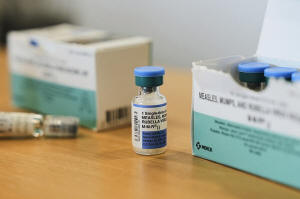Measles vaccination rates drop after COVID-19 pandemic in counties
across the US
[June 05, 2025]
By DEVI SHASTRI and NICKY FORSTER
Childhood vaccination rates against measles fell in the years after the
COVID-19 pandemic in nearly 80% of the more than 2,000 U.S. counties
with available data — including in states that are battling outbreaks
this year.
A Johns Hopkins University study, published in JAMA this week,
illustrates where more vulnerable communities are located. The results
mirror trends established at state and national levels: Routine
childhood vaccination rates are dropping.
“When you look at the state level or national level ... you really don’t
see those drastic drops. Those are there. They’re real and they’re
really problematic,” said Lauren Gardner, an expert in infectious
disease modeling at Johns Hopkins University who is the paper’s senior
author. Gardner also built the university’s COVID-19 database.
Most of the measles cases in the U.S. this year — 1,088 nationally as of
Friday — are in unvaccinated people. It has been spreading among
communities due to international and domestic travel. Three people have
died from measles during this year's outbreaks, and 2025 is inching
closer to becoming the worst for measles in more than three decades.
Measles was eliminated in the U.S. in 2000, and the vaccine is safe and
highly effective. Public schools nationwide require two doses of the
measles, mumps and rubella vaccine before kindergarten, but the number
of children with non-medical exemptions from those requirements hit an
all-time high in the 2023-2024 school year. Health experts say
community-level vaccination needs to be at 95% or higher to prevent
outbreaks.

The Johns Hopkins study looked at 2,066 counties across 33 states,
comparing kindergarten vaccination rates averaged over school years from
2017-2020 to averages from 2022-2024. Where kindergarten data wasn’t
available, the researchers used a comparable rate.
Here's what it looks like in counties where there have been outbreaks
this year, including in Texas counties that are the epicenter of
measles.
Texas
Texas has logged 742 measles cases since late January, most in West
Texas.
Gaines County has 411 cases, the most in the state. Almost 2% of its
population got measles. While the county saw a two percentage-point
increase in vaccination rates after the pandemic, its 82.4% rate remains
below herd immunity.
Terry County (60 cases) and Yoakum County (20 cases) dropped below the
95% threshold for herd immunity after the pandemic, to 93.7% and 91.8%
respectively.
[to top of second column]
|

Vials for the measles, mumps and rubella vaccine are displayed at a
clinic in Lubbock, Texas, on Feb. 26, 2025. (AP Photo/Mary Conlon,
File)
 Lubbock County — which has seen 53
cases and is the closest metro area to Gaines County — was just
below 95% before the pandemic, but dropped three percentage points
after to 91.8%.
El Paso County on the border of Mexico has had the third-most
measles cases in Texas this year with 57. Its vaccination rate is
higher than 95% but saw a 2.1 percentage-point decline to 96.5%.
Kansas
Counties with outbreaks in Kansas include Gray with 25 cases,
Haskell with 11 and and Stevens with seven.
Vaccination rates in Gray County dropped 23 percentage points after
the pandemic, from 94% to 71%.
Haskell County dropped 18 percentage points to 65%. And Stevens
County dropped 0.5 percentage points to 90.5%.
Colorado
Colorado's outbreak, which is linked to an international flight that
landed at the Denver airport in mid-May, involves seven cases: six
in state residents and one out-of-state traveler.
Two people who got measles live in Arapahoe County in the Denver
metro, where the vaccination rate dropped 3.5 percentage points to
88.4%. Three others live in El Paso County, home to Colorado
Springs, where the vaccination rate dropped 3.8 percentage points to
80% post-pandemic.
North Dakota
Pre-pandemic data in North Dakota wasn't available to Johns Hopkins
researchers, but they looked at rates from school years ending in
2022, 2023 and 2024.
North Dakota's first outbreak started in Williams County, which now
has 16 measles cases. In the timeframe researchers looked at,
vaccination rates in Williams rose from 84.6% in 2022 to 87.7% in
2023, only to drop back to 83.5% in 2024.
Cass County has seven cases, and its rate has stayed steady at about
92.7%, while Grand Forks County, which has 10 measles cases, dropped
from 95.4% to 93.4%.
All contents © copyright 2025 Associated Press. All rights reserved
 |